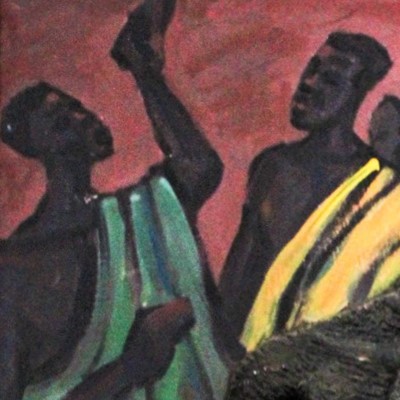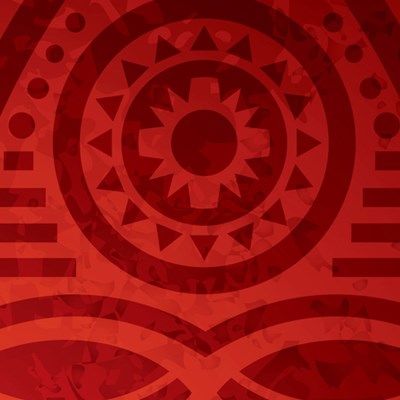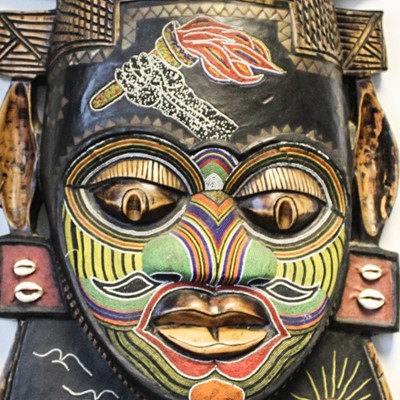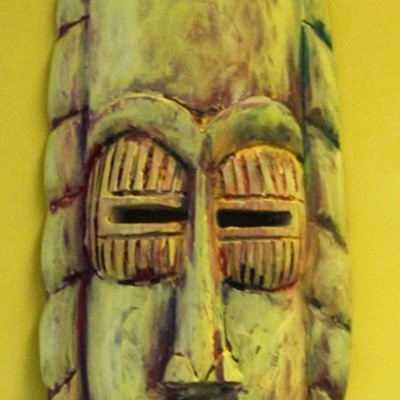Coming of Age

In many African countries, a wide array of rites of passage play a central role in marking the different stages in an individual’s development and their relationship and role to the broader community. Perhaps the most important of these rites is the transition from child to adult, when they become fully entrenched in their community’s cultural customs and ethics. For this reason, it is often claimed by African traditionalists that these rites of passage are critical in nation building and identity formation.
It is not unusual to see women across Africa carrying their babies on their backs as go about their daily chores – working in the field, caring for their own children and those of other women, fetching water and firewood, cleaning their homes and cooking family meals. Young girls learn from their mothers’ example and often care for their younger siblings whilst still young children themselves. From a young age, children in many African countries are taught adult responsibilities and learn from their parents and elders how to work and manage their homestead. They are raised to do their chores without complaint and to treat their parents and elders with utmost respect. Here, children learn to bow or kneel down when greeting elders and not to make direct eye contact or offer handshakes. Children are often considered to be the responsibility of the wider community rather than just of the family, which includes both learning and discipline; the latter is usually strict and may involve verbal chastisement or slapping.
In countries such as the Democratic Republic of the Congo (DRC), it is common for male children to be sent from their homes to an initiation camp. They may spend up to a year in the camp, learning traditional crafts, how to hunt, and perfecting their musical and dancing skills. At the end of their stay, the boys experience a rite of passage into adulthood, which traditional involves circumcision and a festival. The boys then return to their families as men.

Mandinka, Gambia, on coming of age
Traditionally, both male and female circumcision have been carried out amongst the Mandinka. It is more commonly practised in the countryside than in towns and cities in the modern era. Teenage boys are taken out into the bush and initiated into the ways and rules of Mandinka manhood and the medicinal use of plants as part of the rite. The Karakunga spirit is present, in ritual form, for protection.
Sarjo Koita, Mandinka, Gambia, on coming of age ceremonies:
“Circumcision for males, that is also another very big cultural event in my community back home. The village would choose a year and they say…. this year we are going to do circumcision for male children… Can be ranging from ten and below, only children that were not circumcised within that age. They will come together and they will be circumcised. They will group together you know, in one group, and that also is a school that circumcision time because you can stay in that. Sometimes they will take us to the bus, you will not, your mother, no woman not even your mother will not have access to you during that period. So, it’s a school where the elders will teach you… They will show you all you need to know as a man. Being circumcised you have to obey whatever thing they do to you, you have to obey it. So, it’s a very rich tradition because that, after that circumcision you have to learn how to respect your elders.”
Nelson Sule, Benin City, Nigeria on the lack of rites of passage, in his experience, growing up in that city:
“Probably, before I was born…but the time I was born we didn’t have that. But I think the neighbouring tribes still do it up to today. Like, the Ora, the Ora tribe, em, I’ve heard them say they still do it but I’ve never been privy to that.”
Sarjo Koita, Mandinka, Gambia, on male circumcision in Scotland:
“Well, we don’t do that in Scotland here now, like how we do it back home. You can’t do that here because it’s a different environment, different culture, different whatever…So, you can’t do that kind of things here. So, when you have a male child here, you have to do according to what the law says here. So, we don’t definitely do anything like that.”

Wollof
The Wollof circumcision rituals in the Gambia are similar to the Mandinka ones already described but are called Harraf instead of Sunnnaro.
Pa Ebou Ngum, Wollof, Gambia:
“From the day you have the procedure, you are put in a big room and normally they go in, in fives or tens. They are put in a room whereby they have what we call guardians looking after them and those are ones that train them how to be man. Like train them the qualities of honesty, ethics and what come as a man, so as soon as you are healed and about to come out, so that’s the guidance ceremony. It’s a time for celebration as we have men coming out, so that is the motive behind the ceremony. Celebrate the brave man, with dance, drums, sing songs.”
Pa Ebou Ngum, Wollof, Gambia, on coming of age in Glasgow:
“So, we are rulers and warriors, but most of them are griots. We happen to be griots, so that is passed on to me. I am a very cultured person, I am a very cultured person. So… I organise the first cultural festival here in Glasgow…performance, drumming, singing, you know. When boys coming out from circumcision I chant as they walk.”
Blandine Damsk, Bafoussam, Cameroon, on male coming of age rituals:
“In Cameroon we have 208 different cultures in one country. When I say culture, I mean language, dress styles, lifestyles, all these things, so. My Mum and Dad come from different villages, so I will talk about my Mum’s… In my Mum’s village there is a procedures when you have, when you are a teenager, a boy teenager, you are introduced to the Chieftaincy so they organise an event once every two years for teenagers of 13, so during that period they teach you how to be a man, how to become a man. So, they spend two weeks in a house like isolated from their families and friends they are just with the elders of the village, women just cook and bring but they don’t see the boys. They just bring it and the men, the elders, will take the food and go in and they are well fed, because after those two weeks, ooph, they change, because if they were slim, they would just be a bit like…normal, you know (laugh). Sometimes, if you are fat already, you will come out with a big tummy like that (demonstrates)… After six days, on the seventh day, they will release them for eight days, so every day they will go out for about two hours to run all over the city but before going out they have to be scary, so what they do is – one, they don’t dress up, apart from a loin cloth and the rest of the body is painted with black stuff, I don’t know what it is called. You just see the eyes and the teeth, so they’re scary, and they will have some like leaves in their mouths and stuff like that and one leaf in their mouths, one leaf for each person so then they will be running they will be holding the horn of the elephant. They will be running all over the city.”
Blandine explained that they usually did this when the schools came out between the hours of 2pm and 4pm. They would run after people to try and scare them, sometimes giving them a little jab with the horn if they didn’t run away. It is the tradition that everyone runs away from them, no matter what their age is. After two weeks there is a big celebration in the village with food and dancing, everyone attends, the chief, the elders, parents, etc., to witness the ‘new men’ in the village. This day is like a bank holiday and no-one works.

Mende
The Mende people have complex and ordered coming of age ceremonies for both boys and girls called poro and sande initiations respectively. These are secret societies with their own languages and with the goal of teaching the ways of adulthood to the young initiates.
Abdualle, Mende, Sierra Leone, on coming of age ceremonies among the Mende in Sierra Leone:
“Yeah, yeah we do those cultures. We have, those are the main important things that we do not forget, because those are the things our great ancestors, they taught us. You know. Within those cultures, when someone going to get married, pass through, this kind of thing… It’s deep in my own culture, the Mende.”
Abdualle, Mende, Sierra Leone, upon asked if any traditional Mende ceremonies are still carried out in Glasgow:
“Not really. It only happens when it’s like national celebration. For we here now, so we think about that, so we try to celebrate it here as well. And in London where we have a big Sierra Leone community, we celebrate different types of occasion as well.”

The Bull Jumping Ceremony, Hamar, Ethiopia
In the Hamar tribe of Ethiopia, young men seeking permission from a girl’s father to marry his daughter may have to undertake a ritual. Here, to become worthy of marriage, men first have to jump over a herd of cattle. The Bull Jumping Ceremony was traditionally held after harvest time, July to early September, but now it may be held earlier or later in the year. The ceremony begins with young Hamar girls jumping in unison as their heavy metal jewellery forms a rhythmic beat. These girls are often relatives or friends of the boy who is about to be initiated into manhood. The girls will jump towards men, the maza, who have already gone through this rite of passage. The girls hand the maza a green stick, which is then used to whip the girls’ backs as they continue to jump. The lashing continues until blood is drawn and the men then stop; the girls bow to them and jump away. The scars that form show that the women endured pain for the initiate during his passage into manhood. The tribe forms a circle around a herd of cattle and sing. Four of the biggest castrated bulls are lined up side by side and the naked young initiate(s) is brought to the cattle. He must jump onto the first bull and then run back and forth three times across the backs of the four beasts. Once the task is completed, the boy is a maza, or man.

Tuareg Veils
The Tuareg, numbering approximately two million, are a nomadic, mainly Muslim people, who live across the Sahara Desert, including in the North African countries of Mali, Niger, Libya, Algeria and Chad. When Tuareg men reach the age of twenty-five, they begin wearing a veil that covers their whole face, apart from their eyes. This tradition may have begun with the need to protect their faces from the sometimes fiercely blown sands of the desert.

Nuer scarification, South Sudan
The Nuer of South Sudan practice scarification of teenage boys as a rite of passage into adulthood. The scarified marks are usually six vertical lines across the forehead which are called Gaar. This is the case with our respondent Simon. After the rite the boys are not allowed to milk cows, but many other avenues are now open to them. They can marry. They are given a spear and can go on cattle raids. They are also given an ox and an ox name.
Simon Koang, Nuer, South Sudan. Simon is one of only a couple of people in Glasgow from South Sudan:
“Yes, when you get about 18 years old or 15 years old you will get the marks, you get them from 15 to 16… From the day you get the marks you become a man, you will man, you are not a boy anymore… Yah, the day you are going to get the marks. All the village will know of the boy or guy is going to get a mark today. And it will be a group for boys in the village. They put them togethers in one place. The guy who make the marks will come with knife, just cutting. After that they will make a party. Kill two or three bulls and all the family will eat togethers in one place.”
Sean Thomas, Lagos, Nigeria, on his own personal rite of passage in moving to Glasgow:
“Not formally in Lagos...Lagos being a very cosmopolitan city. I know of other African traditions where they have certain ceremonies that mark the rite of passage for young male adults. In my case….I didn’t formally go through any rite of passage. The journeys I took myself which inevitably led me to Scotland, where I am today. So, I could consider that as my own rite of passage. Leaving Africa and coming here and actually having a family and living and working here. So, I would say that is my own rite of passage.”
Ali Abubakar, Zanzibar, left in the early 1960s and converted to Christianity:
“Celebrating the move of Prophet Mohammed from Mecca to Medina, at that time…. depending on the comfort of the family. A boy, so we’re talking about me, will have a certain duty to perform. And that would be killing a goat, skinning it, cutting the meat and share the meat with the families who are not so fortunate. I was going to say rich but fortunate .But, that’s the ceremony, I mean you just give little bits of meat to families around you. But it wasn’t…in my case I learnt vaguely the reason, the purpose of the ceremony, but unfortunately it wasn’t taught…I wasn’t taught deeply about it…. I think what that helped me to see was that ours was a, once again, a fortunate family.”
Simon Koang, Nuer, South Sudan, talks about menstruation:
“Yah, the girls, when the first period come. The father will bring the cow. One cow with milk It will make something traditional. He will put it on this cow. Nobody, no man, no boy, unless the woman like her. The woman can drink the milk. Because this cow is marked to the girl. All the time up till the girl is married. Nobody will drink the milk of this cow. Only the girl or her mother or her sister. When the boys or the brother of the girl drink the milk of this cow, the cow will die. Because there is some traditional, they put on the cow. Because any time the period of the girl come. The girl will not drink all the milk. When there is period time, you will not drink the milk of different cows, only this cow.”
Aya Rashid, Nigeria, on circumcision:
“There are two circumcisions. The male circumcision and the female circumcision. The male circumcision is done quite very quickly, eh, apart from any medical implication or medical process. An African culture does not believe in the infliction of pain and you know the process of circumcision involves pain. The foreskin has to be cut off which is quite painful so they do it before the child is forty days, so the pain will be brief and it will not last long. They have their own ways of sorting out the injuries as well, which is quite quick.”
Next page: Female Circumcision - Female Genital Mutilation (FGM)